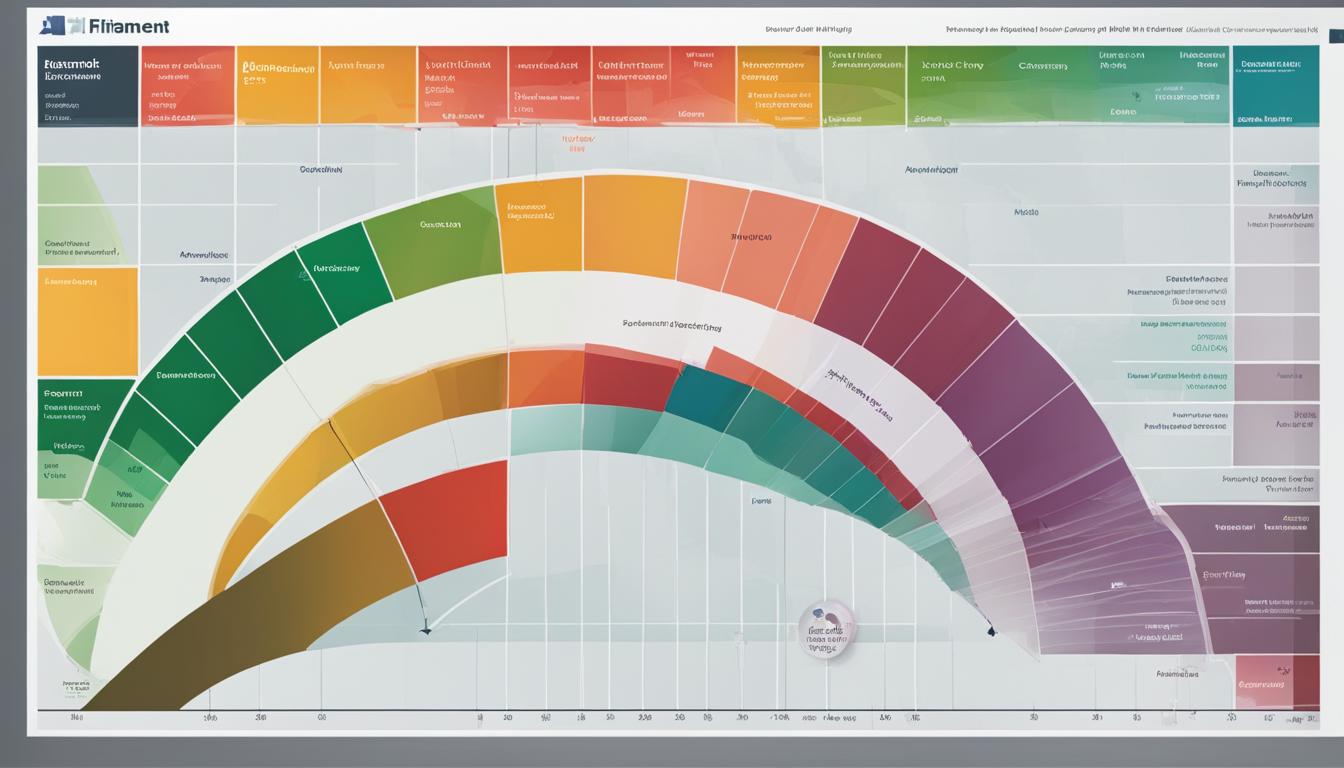Did you know that 45% of Americans have no retirement savings at all?
Planning for retirement is key to a secure future. But, many people make mistakes that can harm their plans. This article shares the top 10 mistakes to steer clear of. By seeing and avoiding these errors, your retirement can be smooth and worry-free.
Key Takeaways:
- Starting early is crucial for retirement planning to take advantage of compound interest and long-term growth.
- Contributing enough to retirement accounts and taking advantage of employer matches can maximize your savings.
- Diversify your investments to protect your retirement savings from market volatility.
- Consider inflation and rising healthcare costs when planning for the future.
- Maximize tax-advantaged retirement accounts to optimize your retirement income.
Introduction:
Retirement planning is vital for a stable financial future. It involves managing money wisely, saving as much as you can, and investing smartly. This way, you can protect your wealth and ensure a happy retirement. Even though there’s lots of advice out there, many people still mess up their retirement planning. In this article, we aim to show you how to dodge these mistakes and do better.
Why bother reading about retirement planning again? Because it’s key to financial security and a worry-free future. By steering clear of common blunders and adopting sound retirement strategies, you can boost your savings, make your investments work harder, and safeguard your wealth. This sets you up for an enjoyable retirement.

Mistake #1: Not Starting Early Enough
One big mistake in retirement planning is not starting early. Compound interest can greatly boost your savings over time. By starting late, you lose this powerful advantage for growth.
Starting early is key because your money has more time to grow. This way, you can get the most out of your investments. This holds whether your aim is a comfy retirement, paying for education, or buying a dream house.
“Compound interest is the eighth wonder of the world. He who understands it, earns it… he who doesn’t… pays it.”
– Albert Einstein
Starting early helps you avoid delayed planning’s pitfalls. It’s common to put off retirement planning due to other urgent needs or thinking there’s plenty of time. But delaying planning can cost you dearly in the future.
Choosing to plan early for retirement sets the stage for a safe financial future. It’s always a good time to get started and leverage compound interest for your financial success. The benefits are more than worth it for your long-term financial plans.

Mistake #2: Not Contributing Enough to Retirement Accounts
Many people don’t put enough money into their retirement accounts. They know they should save but often fall short of their goals. This part will show ways to make your contributions count more for a better financial future.
Maximizing Your Employer Match: How to Get the Most Out of Your Retirement Contributions
If your job has a 401(k) or IRA, you should join. Especially because of the free money from your employer’s match. Employers usually match a part of what you put in, giving you extra savings without spending more.
Make sure you’re getting the most from your employer’s match. Read what your company offers and put in enough to get the full match. This boosts your savings without extra cost.
The Importance of Consistent Contributions: How Regular Savings Can Add Up Over Time
It’s really important to save regularly for retirement. Even small amounts each month can grow with time. You’ll benefit from the power of compound interest.
Saving regularly is crucial. It shows you’re serious about your future. You can set up automatic savings or aim to save a certain amount each month. This makes saving easier and keeps your budget in check.

Mistake #3: Not Diversifying Your Investments
One mistake in retirement planning is not diversifying your investments. Putting all your money in one place risks your savings. Diversification means spreading your investments out. This strategy lowers the impact of market changes.
Think of asset allocation to see why this is important. This is how you divide your money among different types of assets. This could be stocks, bonds, real estate, or commodities. A diverse portfolio helps manage risk and aims for success in the long run.
“Diversification is the key to reduce risk and increase the stability of your retirement savings.”
Diversification has several upsides. It guards your savings from dips in the market. With varied investments, if one does badly others may do well. This lessens how much a loss affects you.
It can also open doors to more gains. By spreading your money over different areas, you might win when some markets do well. This lets you win big while keeping risks low.
Finally, it matches your savings with what you can handle and want. With the right mix of investments, you create a plan that fits you. This can change with age, your goals, and what you have. So, your savings stay right for you over time.
Adding diversity needs you to think about what you want, how much risk you’re okay with, and where you want to put your money. Talking to an expert or using online tools can help. Don’t forget to check and adjust your investments as needed. This keeps your plan diverse as things change.
Remember, spreading your risk is vital for a strong retirement plan. It protects your savings, controls your risk, and aims for a bright financial future.
| Benefits of Investment Diversification | Strategies for Maintaining a Balanced Portfolio |
|---|---|
| 1. Protects retirement savings from market fluctuations | 1. Regularly monitor your portfolio’s performance |
| 2. Provides potential to benefit from different investment opportunities | 2. Rebalance your portfolio periodically |
| 3. Aligns portfolio with risk tolerance and financial goals | 3. Diversify across different asset classes and sectors |
Mistake #4: Not Considering Inflation and Rising Healthcare Costs
Retirement planning isn’t just about saving a lot of money. You need to think about many things that could affect your retirement funds. Overlooking inflation and increasing healthcare expenses is a common mistake. It can hurt your savings and financial plans.
The Silent Thief: How Inflation Can Erode Your Retirement Savings
Inflation means things cost more over time. The money you saved will buy less in the future. This can affect your retirement fund’s purchasing power.
When planning for retirement, always factor in inflation. Without doing so, your savings might not cover future costs. Make sure you save enough to keep living as you want during retirement.
To fight inflation’s impact, use strategies that protect your money. Invest in stocks, real estate, or consider TIPS. These steps can help your savings keep up with inflation.
Planning for the Unexpected: How to Factor in Rising Healthcare Costs
Healthcare costs will likely go up as you get older. Not planning for this rise can stress your budget in retirement. It’s a key point to consider.
In the U.S., healthcare costs increase more than general inflation. This covers everything from medicine to long-term care. Not including them in your plan could be a big mistake.
Think about costs like insurance, copayments, and long-term care. Look into long-term care insurance too. This can help you save enough for health expenses in retirement.
By including healthcare costs in your plan, you can ensure you’re ready. This way, your savings can cover medical needs in retirement.
Remember, planning ahead for inflation and rising healthcare costs is crucial. By considering these factors, you can secure your financial future and a happy retirement.
Mistake #5: Not Maximizing Tax-Advantaged Retirement Accounts
Not using tax-advantaged retirement accounts well is a big mistake in retirement planning. These accounts can save you a lot in taxes. They can greatly increase your retirement savings over time.
By using accounts like IRAs, 401(k)s, and Roth IRAs, you can make your retirement income more efficient. This will also lower the amount you pay in taxes.
Tax-Advantaged Retirement Accounts: How to Make the Most of Your Savings
Tax-advantaged retirement accounts have many benefits. You can save a lot, thanks to accounts like IRAs and 401(k)s. They let you put in money each year without paying taxes on it or with a tax break.
Adding money to these accounts can save you a lot in taxes. And, depending on the account, your money can grow without taxes or almost no taxes. This helps your savings grow faster.
When choosing what accounts to use, look at trends like limits , who’s eligible, and if your employer matches what you save. A financial advisor can help you pick the best options based on your needs and goals.
Reducing Your Tax Burden: How to Optimize Your Retirement Income
Planning for taxes is key in retirement planning. Being smart with where you take your money from in retirement can cut down on taxes. This lets you keep more money in hand.
One good plan is to manage when you take out money from different accounts. Doing this wisely can lower your taxes. For example, using Roth IRA money when you earn less can reduce how much you owe in taxes.
Also, don’t forget about tax breaks for retirement costs. Things like medical bills and contributing to retirement plans can get you tax benefits. This helps a lot in making the most of your taxes.
Speaking with a tax expert or financial advisor can point you in the right direction. They understand the tax system and can build a personal tax plan for you. This can help lower your taxes in retirement.
Mistake #6: Not Having a Sustainable Withdrawal Strategy
Forgetting a plan to withdraw money wisely is a big mistake in saving for retirement. Without a good plan, your money might not last through retirement, making you struggle later on. It’s key to create a plan that lets you spend while still saving.
Avoiding the 4% Rule: How to Create a Sustainable Withdrawal Strategy
The 4% rule says you can take out that much from your savings each year in retirement. This figure changes in the following years to match inflation. While a good starting tip, it’s vital to make a plan specific to your needs and aims.
Making a good plan involves knowing your costs and being realistic. Figure out what your retirement will cost, including home, health, fun, and surprise expenses. Do this to set a smart spending rate that meets your goals without exhausting your funds.
How inflation affects your money is also important to think about. Inflation means the value of your dollar drops over time. So, you must increase how much you withdraw to counter these rising costs. This keeps your retirement money useful throughout the years.
Making Your Retirement Savings Last: How to Plan for a Long and Comfortable Retirement
Aside from a withdrawal plan, there are extra ways to stretch your savings. Make a detailed budget to manage your spendings and keep up with your earnings. Focus on what you must spend on and cut back on the extras to make your money go further.
Also, think about how long you’ll need your savings to last. With people living longer, your money has to support you for more years. Look into options like annuities for steady income for life, or adjust how you invest to tackle this.
Last but not least, always update and tweak your withdrawal plan. Your financial needs will change, and your plan should too. Getting advice from a professional can offer the right direction to a stable and happy retirement.
| Key Steps to Creating a Sustainable Withdrawal Strategy | Benefits |
|---|---|
| 1. Estimate your retirement expenses | – Ensure your withdrawals align with your financial goals – Avoid running out of money in retirement |
| 2. Factor in inflation | – Protect your purchasing power over time – Adjust your withdrawals to cover rising costs |
| 3. Implement a comprehensive budget | – Manage your expenses and income effectively – Stretch your retirement savings further |
| 4. Consider longevity risk | – Ensure your savings support a long and comfortable retirement – Explore options like annuities for guaranteed income |
| 5. Regularly review and adjust your strategy | – Adapt to changes in your financial situation and needs – Seek professional advice for personalized guidance |
Mistake #7: Not Reviewing and Updating Your Retirement Plan Regularly
Many people make the mistake of not keeping their retirement plan up to date. Your financial situation and what you want might change. If you don’t review and update your plan, you could miss your retirement goals.
Staying on Track: How Regular Reviews Can Help You Achieve Your Retirement Goals
It’s important to check your retirement plan often. This helps you see how you’re doing. You can find what’s missing and fix things to reach your goals. Making regular checks keeps your plan right for you.
Look at your retirement dreams again, see how your money is doing, and think about big life events. Keeping a close watch lets you make smart choices to get the retirement you want.
Adapting to Change: How to Update Your Retirement Plan to Reflect Your Evolving Needs
Life changes, and so do your retirement needs. It’s key to update your plan as things shift. This keeps your plan working well for you.
When life changes happen, update your money plans too. Check your retirement money goals again. Make sure what you’re willing to risk and how you invest your money still match up. Think about events like getting married, having a baby, or tough times like losing a job. These might need you to plan your money in new ways.
It’s important to make sure your money is in the right places for the long term. Review your investment choices and how you spread your money out. By doing this, you can handle changes better, grab new chances, and make sure you’re making good choices for your retirement.
| Benefits of Regularly Reviewing and Updating Your Retirement Plan |
|---|
| 1. Stay on track towards your retirement goals |
| 2. Identify and address any gaps or areas of concern |
| 3. Reassess your retirement goals and aspirations |
| 4. Evaluate the performance of your retirement investments |
| 5. Consider and account for life events and milestones |
| 6. Make financial adjustments based on evolving needs |
| 7. Rebalance your portfolio to maintain alignment with goals |
Mistake #8: Not Considering Long-Term Care Costs
Many people forget about long-term care costs when planning for retirement. Such expenses, especially for nursing homes or assisted living, can heavily impact your finances later. Not preparing for these costs might leave you in a tough spot.
The Hidden Cost of Long-Term Care: How to Plan for the Unexpected
The price of long-term care can eat up your savings fast if you’re not ready. Nursing homes, assisted living, and home healthcare can be very costly. Knowing the financial effects and planning for them is key.
Long-term care insurance is one solution. It covers services like nursing care, help with daily tasks, and medical needs for chronic diseases. This insurance can protect your money and make sure you’re covered.
Medicaid can help too if you don’t have much money. It’s a government program that aids low-income people with healthcare, including long-term care. But, each state has its own rules, so be sure to check if you qualify.
Protecting Your Assets: How to Factor in Long-Term Care Costs
Planning for retirement means also planning for long-term care costs. It’s vital for protecting your finances and ensuring you can afford care when you need it.
Include these costs in your retirement budget. This foresight helps you set aside money just for long-term care. Doing so can keep you from using up your savings or solely depending on Medicare.
Estate planning is another way to secure your finances. With a detailed plan that includes wills and trusts, you can guide the division of your assets. This step reduces how much long-term care costs may affect your estate.
To sum up, it’s essential to think about long-term care costs in your retirement plans. By being prepared and looking into solutions like insurance and Medicaid, you can safeguard your financial future. This approach offers peace of mind as you enter your retirement years.
Mistake #9: Not Having a Plan for Retirement Income
Retirement planning without clear income steps is a big mistake. It can lead to financial worries later on. Creating a retirement paycheck is key. It helps support your lifestyle.
Creating a Retirement Paycheck: How to Ensure a Steady Income Stream
Various sources offer income for retirement:
- Annuities provide steady payments. This is good for retirement.
- Social Security is vital for many retirees’ incomes. Know how to get the best out of it.
- If you have a pension, it offers a reliable income. Understand when you can start getting it.
- Retirement accounts, like 401(k)s, also help. Manage these wisely for ongoing income.
Diversifying your retirement income sources is smart. It lowers the risk of one source failing.
From Savings to Income: How to Convert Your Retirement Assets into a Sustainable Income
Planning to turn your assets into a lasting income takes thought. Here’s what you should do:
- Figure out what you’ll need money for in retirement. This includes living costs, healthcare, and fun activities. Knowing your expenses helps set your income target.
- Check how much income you’ll have against your expenses. If you see a gap, plan how to fill it. This might mean saving more.
- Choose how to take out money from your savings. The 4% rule or other methods can provide a paycheck. Pick one that fits your plans best.
- Plan for a long retirement. Factor in inflation and rising health costs. Adjust your lifestyle needs too. This helps your money last longer.
- Getting advice from a financial advisor is wise. They can offer tips and create a plan for you. This plan should meet your retirement goals and finances.
A solid retirement income plan is essential. It ensures a stable and happy retirement. With the right strategy, you can retire with confidence.
Mistake #10: Not Reviewing and Updating Beneficiary Designations
Estate planning in retirement is key, but many forget to update who gets what in their will. This oversight can lead to problems. Your assets might not go where you want if this step is missed.
When you name who gets your stuff after you’re gone, these choices are super important. They come before what your will says. So, be sure to tell the right people who your wishes are for.
It’s not a one-time thing. You should check and maybe change these plans every so often. If you get married, have kids, or some other big change, think about updating this. It’s about making sure your loved ones get what you intended for them.
Outdated plans could mess things up. Your money or things might not end up where you wanted. This could lead to fights or leave someone out.
Keep your plans in line with what you really want. This means keeping things up-to-date, always. By doing this, you make sure your things go where you mean for them to. It also helps avoid legal headaches for your family.
Get help from a pro to make sure your plans are right. Meet with an estate planner or a finance expert. This simple step can save your family a lot of trouble and ensure your wishes are carried out.
Conclusions
Avoiding retirement planning mistakes is key for a cozy retirement. This article suggests ways to boost your savings and keep your investments smart. It’s vital to protect what you already own and look ahead. Keep your retirement plan up to date, think about long-term care, and secure a steady income. By making thoughtful choices, you’re on the path to a satisfying retirement.
FAQ
What are the top 10 retirement planning mistakes to avoid?
The top 10 retirement mistakes include not starting early or saving enough. Not spreading your money over different investments is another. Forgetting to plan for rising costs, like healthcare and inflation, is common too.
Maximizing tax breaks and drawing a sustainable income are crucial. So is updating your plan and beneficiary choices regularly. Ignoring long-term care costs and a solid retirement income plan are also big flaws.
Why is retirement planning important?
Retirement planning secures your financial future. It helps you handle your money well and plan for savings and investments. It covers costs you won’t expect, like health care, and protects what you’ve earned.
Avoiding simple mistakes can make your retirement better. This way, you can ensure your later years are enjoyable.
How does starting early in retirement planning benefit me?
Starting early in saving for retirement is key. It lets your money grow over many years with compound interest. This can significantly boost your savings over time.
Wait too long to start, and you miss out on big saving opportunities. Begin your plan early and your future self will thank you.
How can I maximize my retirement contributions?
To put the most in your retirement fund, use all your employer’s matching benefits. Contribute regularly and understand what perks your 401(k)s and IRAs offer. This can help your savings grow well for your retirement.
Why is it important to diversify investments in retirement planning?
Diversifying your money helps protect your future savings. By choosing a mix of investments, you lessen the risk of losing everything at once. It’s a smart way to plan for the long-term.
Make sure your investment mix is varied. It will make your retirement fund more secure.
How do inflation and rising healthcare costs affect retirement planning?
Inflation can eat away at your savings, so plan for it. Rising health costs can hit your retirement hard, too. Be proactive in safeguarding your money against these future expenses.
What are tax-advantaged retirement accounts, and how can I make the most of them?
IRAs and 401(k)s offer great tax benefits for retirement savings. Understand their tax perks for better saving and withdrawal strategies. By planning carefully, you can reduce your tax bill and boost your nest egg.
How can I create a sustainable withdrawal strategy for retirement?
For a steady retirement income, start with a solid budget and account for all expenses. Make sure your savings last by considering future lifestyle changes and inflation.
You can enjoy a comfortable retirement by planning ahead wisely.
Why should I regularly review and update my retirement plan?
Routinely checking your retirement plan keeps you on the right path. It helps you adjust to changes and grab new chances. By staying current, you keep your plan perfect for you and your goals.
How do I plan for long-term care costs in retirement?
Long-term care costs should be part of your retirement plan from the start. Know what care might cost and look into insurance or Medicaid. Protecting your assets early ensures a worry-free retirement.
What are some strategies for creating a retirement income plan?
Annuities, Social Security, and pensions are good to include in your plan. Transforming your savings into a steady income is also important. A well-rounded plan brings financial security and peace in your later years.
Why is it important to review and update beneficiary designations in retirement planning?
Regularly checking your beneficiary designations is crucial. It ensures your assets go where you want. With updated choices, you avoid unwanted complications and ensure your peace of mind.




Leave a Reply